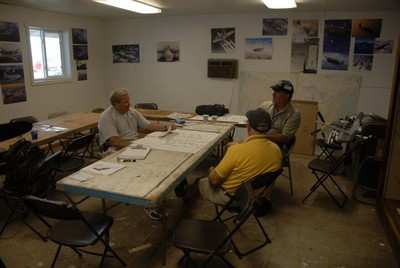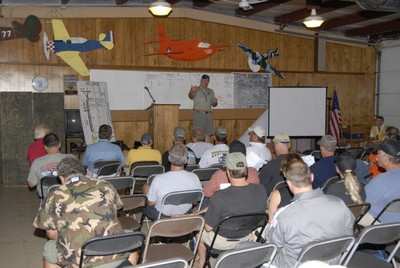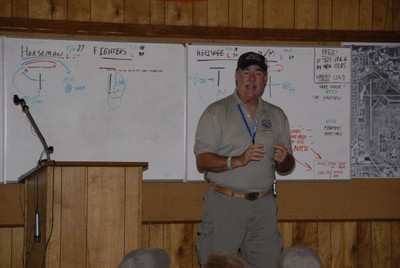Daily Shows Planned, Written, And Coordinated By
Crack Team
by ANN Correspondent Matt Russell
Wayne “Boss” Boggs is a busy man during
“airshow season,” but he was kind enough to let ANN
trail him for a couple days at AirVenture. A retired FAA official,
Boggs now travels the country directing airshows as an Air Boss. In
this position, he is responsible to produce an airshow that is
safe, timely, and action-packed, no matter the conditions or
location.

At Oshkosh, Boggs explains how the AirVenture shows must each be
split into two halves. “The show is just too big,” he
says. “So we have a warbird half, which I am responsible for,
and then the aerobatic half, for which I am the backup Air
Boss.”
As the Warbird Air Boss, Boggs does what amounts to a juggling
act -- launching, showing, and “recovering” up to
75 aircraft at once. The only way to make this happen, he says, is
with absolutely thorough planning.
We caught up with Mr. Boggs at an early planning session for the
day’s show. Deep in the Warbird Headquarters building at
Wittman Field, Boggs, George Cline, and Mark Ringham carefully
deliberate over a map of the airport. They compare show notes from
the prior day’s show, and discuss what they’d like to
do differently. It is obvious they have spoken to the performing
pilots since the prior show, and each of the three men has brought
notes to the meeting about elements of the show needing attention.
As the men scribble away, new ideas seem to crop up, and are either
confirmed as viable or tossed aside.

Brainstorming complete, one of the three men volunteers to
transcribe all notes into a clear, sequenced show plan. This is the
document that will be used to steer the pilot briefing, scheduled a
couple of hours before the show actually begins.
At the pilot briefing, also in Warbird Headquarters, Boggs takes
the stage and greets the pilots. It is perhaps the most crucial
part of the day, because many problems can be solved in advance of
the show. The briefing will begin and end with the reminder
“Safety first.”

“We are fortunate to have one of the greatest announcers
in the entire airshow industry representing us and the
warbirds,” says Boggs, referring to Danny Clisham. “I
think he will represent you well. If you would like something said
especially about yourself or your aircraft, be sure to let him
know.”
Boggs continues the briefing, “I also have two of the
finest individuals in the world assisting me… we are a team
up there, Mr. George Cline and Mr. Mark Ringham. There will be
times that you will not hear my golden tones on the
frequency… we move it around. In fact, today, Mark will be
doing the talking up there and George will run the [east-west
runway].” Boggs finishes the introduction with a joke,
“I will be standing up there, having a little cheese and wine
as they work.” The crowd roars but as the laughter dies, the
tone becomes serious again.
“Alright Ladies and Gentlemen, by my watch in 10 seconds
it will be exactly twenty minutes til’ One... it is now
twenty minutes ‘til. WEATHER,” barks Boggs, pointing to
a seated official. The man stands up and begins a detailed weather
briefing as pilots scribble notes. “Between 4000 and 8000
feet, visibility will be unrestricted. Surface winds are about 220
at ten. If anybody’s been outside, you know there are
buildups to the north and east. If you see something that looks
interesting you should give Wayne a call for a heads-up on
it,” continues the briefer. “Winds at 3000 feet are
about 210 and ten. Any questions?”
The crowd has none; most of these pilots are Oshkosh veterans.
“Have a safe show,” says the briefer, who receives a
round of applause.

Next item on the agenda is for Boggs to explain the definition
of “waivered” air space. He introduces the FAA
representative sitting in the front row, and proceeds to spend the
next several minutes in deep review of a large, wall mounted
satellite photo showing Wittman Field. Reference points, boundary
markers, and regulations are all detailed, with ample opportunity
for questions from the pilots. Because they briefing is so
thorough, there are few questions.
During the next portion, Boggs takes into account the needs of
individual airplanes. “Who besides the Spitfire has an
overheating problem?” he asks. “I know you all will
overheat eventually, but who has a really urgent concern about
this?”
Next, Boggs introduces Jon Eisele of Warbirds of America, to
brief the pilots on ground operations during the airshow. Eisele
points out all areas of interest on a large airport diagram, and
makes requests of the pilots to ease traffic congestion on the
field.

Boggs is ready to wrap up the briefing, but before he does, he
spends a moment to advise the pilots on judgment. “On those
lines, you and you alone know what your limitations are. You know
how you feel, you know your craft, you know what you do,” he
says to a room of stone silence. “I don’t fly the
airplane for you… I never get in the cockpit with you, but
if it doesn’t feel right, don’t do it. If it’s
just a day that feels out of sync, don’t do it. Most of you
don’t [regularly] fly with each other. So you want to be
confident of what you do. Remember, people are amazed the damn
things fly anyway... you do not need to live on the outside of your
envelope. Stay in your comfort zone. It’s as simple as
that.”
To close the briefing, Boggs presents a large easel, on which
has been written the precise timing of the show. Each segment is
planned down to the minute, and pilots have only a couple of
questions.
Most of their time is spent taking copious notes. Finally, Boggs
introduces the ground control team for the Warbirds parking area.
They receive a round of applause. Boggs details frequencies,
altimeter settings, alternate airports, and a myriad of other small
details. Then he reminds each Warbird flight group to hold their
own briefing, and the meeting is adjourned. It’s time for the
show.
ANN will have more from the flight line... stay tuned!
 ANN's Daily Aero-Term (04.20.24): Light Gun
ANN's Daily Aero-Term (04.20.24): Light Gun Aero-News: Quote of the Day (04.20.24)
Aero-News: Quote of the Day (04.20.24) ANN's Daily Aero-Linx (04.21.24)
ANN's Daily Aero-Linx (04.21.24) Aero-News: Quote of the Day (04.21.24)
Aero-News: Quote of the Day (04.21.24) ANN's Daily Aero-Term (04.21.24): Aircraft Conflict
ANN's Daily Aero-Term (04.21.24): Aircraft Conflict







